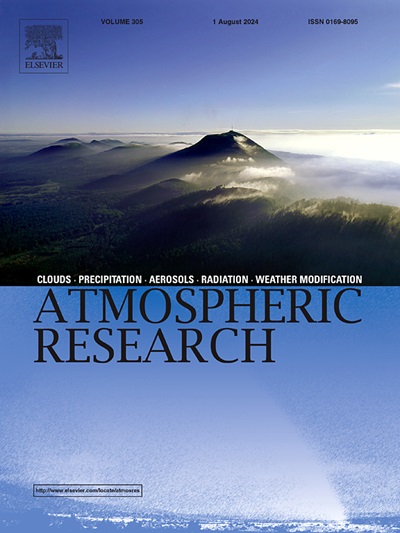南极冬季平流层涡旋增强:区域海表温度的贡献
IF 4.4
2区 地球科学
Q1 METEOROLOGY & ATMOSPHERIC SCIENCES
引用次数: 0
摘要
南极平流层极涡是冬季平流层系统的一个重要特征。南极SPV强度的变化对南半球的天气和气候有重要影响。虽然前人的研究对南极SPV强度的变化及其物理机制有了较好的认识,但2000年以后南极SPV的变化趋势并没有得到足够的重视。通过观测和再分析发现,2000-2022年期间,中部SPV在南方冬季有增强的趋势。研究结果表明,海温变暖改变了大气对流和行星波活动,减少了进入平流层的波数-1行星波,从而加强了极地涡旋。利用气候模式下的理想海表温度(SST)斑块试验,量化了各区域海表温度变暖的具体贡献。其中,2000 - 2022年热带大西洋、北印度洋、西太平洋暖池和东太平洋对极地涡旋降温的贡献率分别为106.86%、- 52.67%、- 40.72%和36.94%。在年代际时间尺度上,热带海温型态的变率,特别是大西洋和太平洋盆地的变率,对形成近几十年来观测到的南极特别温趋势和波动至关重要。本文章由计算机程序翻译,如有差异,请以英文原文为准。
Enhanced Antarctic stratospheric vortex in austral winter: Contributions from regional sea surface temperature
The Antarctic stratospheric polar vortex (SPV) is a crucial feature of the stratospheric system in winter. The variation in the strength of the Antarctic SPV significantly impacts the weather and climate of the Southern Hemisphere (SH). Although previous studies have provided a good understanding of the variations in the strength of the Antarctic SPV and its associated physical mechanisms, the trend of the Antarctic SPV after 2000 has not received sufficient attention. Here, based on observations and reanalysis data, we find that the middle SPV has a strengthening trend in austral winter during 2000–2022. Our findings indicate that warming SST alter atmospheric convection and planetary wave activity, reducing wavenumber-1 planetary waves into the stratosphere and thereby strengthening the polar vortex. Using idealized sea surface temperature (SST) patch experiments with a climate model, we quantified the specific contributions of SST warming in various regions. Among these, the tropical Atlantic, North Indian Ocean, West Pacific warm pool, and East Pacific contributed 106.86 %, −52.67 %, −40.72 %, and 36.94 %, respectively, to the cooling of the polar vortex from 2000 to 2022. On decadal timescales, the variability of tropical SST patterns, particularly in the Atlantic and Pacific basins, has been critical in shaping the observed trends and fluctuations in the Antarctic SPV during recent decades.
求助全文
通过发布文献求助,成功后即可免费获取论文全文。
去求助
来源期刊

Atmospheric Research
地学-气象与大气科学
CiteScore
9.40
自引率
10.90%
发文量
460
审稿时长
47 days
期刊介绍:
The journal publishes scientific papers (research papers, review articles, letters and notes) dealing with the part of the atmosphere where meteorological events occur. Attention is given to all processes extending from the earth surface to the tropopause, but special emphasis continues to be devoted to the physics of clouds, mesoscale meteorology and air pollution, i.e. atmospheric aerosols; microphysical processes; cloud dynamics and thermodynamics; numerical simulation, climatology, climate change and weather modification.
 求助内容:
求助内容: 应助结果提醒方式:
应助结果提醒方式:


